A tool to easily create informative genomic feature plots
Project description


SeqFindr - easily create informative genomic feature plots.
- Work in progress:
SeqFindr is nearing a stable API.
We have only tested SeqFindr on linux systems. There has been some success with MacOSX.
Best use “git log” for a changelog as the changelog for most recent changes/fixes/enhancements may not be up to date.
Cite this Github repository if you use SeqFindr to generate figures for publications:
STANTON-COOK M, NF ALIKHAN, FORDE BM, BEN ZAKOUR NL & BEATSON SA^. SeqFindr - easily create informative genomic feature plots. https://github.com/mscook/SeqFindr.
Quick install (Ubuntu)
Simple install for Ubuntu/Debian systems:
$ sudo apt-get install python-numpy python-scipy python-matplotlib python-biopython ncbi-blast+ python-dev python-pip libatlas-dev liblapack-dev gfortran libfreetype6-dev libfreetype6 libpng-dev git && cd ~/ && git clone https://github.com/mscook/SeqFindr.git && pip install -e SeqFindr/
Requirements
- You’ll need to install/have installed:
ncbiblast >= 2.2.27
python >= 2.7 (Python 3 is not supported)
git (depending on your install route)
You can check these are installed by:
$ python --version $ which blastn $ which pip $ which git
The following python libraries should be installed automatically if you follow the installation instructions detailed below.
- We use the following python libraries:
numpy >= 1.6.1
scipy >= 0.10.1
matplotlib >= 1.1.0
biopython >= 1.59
ghalton>=0.6
These libraries will also have dependencies (i.e. atlas, lapack, fortran compilers, freetype and png).
The state of Python packaging (distribution of code) is that bad, you could miss many nights sleep. I’m looking at you SciPy. For the smoothest possible install we recommend installing the requirements using your distributions package manager. That is via apt-get, yum or similar.
For Ubuntu (fresh server install) you can get requirements using:
$ sudo apt-get install python-numpy python-scipy python-matplotlib python-biopython ncbi-blast+ python-dev python-pip libatlas-dev liblapack-dev gfortran libfreetype6-dev libfreetype6 libpng-dev git
Installation (possibly painful)
If you are a member of the Beatson Group you’ll already have SeqFindr in your $PATH on barrine. You do not need to install SeqFindr. UQ based researchers should email me (m.stantoncook@gmail.com) for the location of SeqFindr.
Option 1a (with root/admin):
$ pip install SeqFindr
Option 1b (as a standard user):
$ pip install SeqFindr --user
This assumes you have pip installed (see pip). The SciPy, NumPy and matplotlib installations will break if you are missing libraries such as atlas, lapack, fortran compilers, freetype and png).
You’ll need to have git installed for the following alternative install options. git can be really useful for scientists. See here for some discussion. Installing this way will provide you with the most recent version of SeqFindr.
Option 2a (with root/admin & git):
$ cd ~/ $ git clone git://github.com/mscook/SeqFindr.git $ cd SeqFindr $ sudo python setup.py install
Option 2b (standard user & git) replacing INSTALL/HERE with appropriate:
$ cd ~/ $ git clone git://github.com/mscook/SeqFindr.git $ cd SeqFindr $ echo 'export PYTHONPATH=$PYTHONPATH:~/INSTALL/HERE/lib/python2.7/site-packages' >> ~/.bashrc $ echo 'export PATH=$PATH:~/INSTALL/HERE/bin' >> ~/.bashrc $ source ~/.bashrc $ python setup.py install --prefix=~/INSTALL/HERE/SeqFindr/
If the install went correctly:
$ which SeqFindr /INSTALLED/HERE/bin/SeqFindr $ SeqFindr -h
Please regularly check back to make sure you’re running the most recent SeqFindr version. You can upgrade like this:
If installed using option 1x:
$ pip install --upgrade SeqFindr $ # or $ pip install --upgrade SeqFindr --user
If installed using option 2x:
$ cd ~/SeqFindr $ git pull $ sudo python setup.py install $ $ # or $ $ cd ~/SeqFindr $ git pull $ echo 'export PYTHONPATH=$PYTHONPATH:~/INSTALL/HERE/lib/python2.7/site-packages' >> ~/.bashrc $ echo 'export PATH=$PATH:~/INSTALL/HERE/bin' >> ~/.bashrc $ source ~/.bashrc $ python setup.py install --prefix=~/INSTALL/HERE/SeqFindr/
Example figure produced by SeqFindr
SeqFindr CU fimbriae genes image. 110 E. coli strains were investigated. Order is according to phylogenetic analysis. Black blocks represent gene presence.
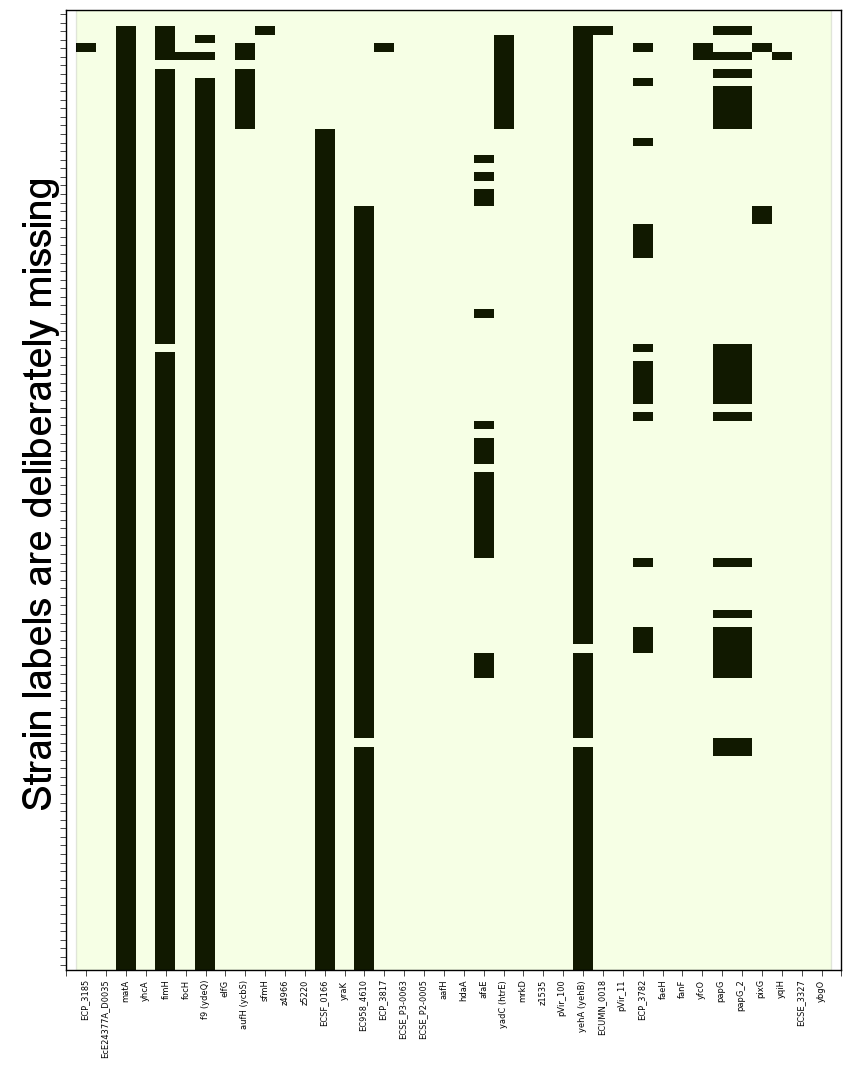
SeqFindr database files
The SeqFindr database is in multi-fasta format. The header needs to be formatted with 4 comma separated elements. We concede that inventing another file format is annoying, but, future versions of SeqFindr will exploit this information.
- The elements headers are:
identifier,
common name (this is taken as the gene label in the plot),
description and
species
The final element, separated by [] contains a classification. This information is used by SeqFindr to draw different coloured blocks.
An example:
>70-tem8674, bla-TEM, Beta-lactams Antibiotic resistance (ampicillin), Unknown sp. [Beta-lactams] AAAGTTCTGCTATGTGGCGCGGTATTATCCCGTGTTGACGCCGGGCAAGAGCAACTCGGTCGCCGCATAC >70-shv86, bla-SHV, Beta-lactams Antibiotic resistance (ampicillin), Unknown sp. [Beta-lactams] CTCAAGCGGCTGCGGGCTGGCGTGTACCGCCAGCGGCAGGGTGGCTAACAGGGAGATAATACACAGGCGA >70-oxa(1)256, bla-OXA-1, Beta-lactams Antibiotic resistance (ampicillin), Unknown sp. [Beta-lactams] >70-tetB190, tet(B), Tetracycline Antibiotic resistance (tetracycline), Unknown sp. [Tetracycline] CAAAGTGGTTAGCGATATCTTCCGAAGCAATAAATTCACGTAATAACGTTGGCAAGACTGGCATGATAAG
Note: if you do not have all information you can simplify the expected database header to:
>, bla-TEM, , [classification]
The script vfdb_to_seqfindr is now included in SeqFindr to convert VFDB formatted files (or like) to SeqFindr formatted database files.
VFDB: Virulence Factors Database (www.mgc.ac.cn/VFs/) is a reference database for bacterial virulence factors.
At this stage we have tested this script on limited internal datasets. Success/mileage will depend on the consistency of the VFDB formatting.
Example usage of vfdb_to_seqfindr:
# Default (will set VFDB classification identifiers as the classification) $ vfdb_to_seqfindr -i TOTAL_Strep_VFs.fas -o TOTAL_Strep_VFs.sqf # Sets any classification to blank ([ ]) $ vfdb_to_seqfindr -i TOTAL_Strep_VFs.fas -o TOTAL_Strep_VFs.sqf -b # Reads a user defined classification. 1 per in same order as input # sequences $ python convert_vfdb_to_SeqFindr.py -i TOTAL_Strep_VFs.fas -o TOTAL_Strep_VFs.sqf -c user.class
The -c (–class_file) option is very useful. Suppose you want to annotate your sequences of interest with user defined classification values. Simply develop a file containing the scheme as pass using the -c option (3rd example above). A sample file for the situation where you had 7 input sequences with the first 3 Fe transporters, the next two Toxins, the next a Misc and the final sequence is a Toxin would look like this:
Fe transporter Fe transporter Fe transporter Toxin Toxin Misc Toxin
How does SeqFindr determine positive hits
We use the following calculation:
hsp.identities/float(record.query_length) >= tol
- Where:
hsp.identities is number of identities in the high-scoring pairs between the query (database entry) and subject (contig/scaffold/mapping consensus),
record.query_length is the length of the database entry and,
tol is the cutoff threshold to accept a hit (0.95 default)
For a database entry of 200 bp you can have up to 10 mismatches/gaps without being penalised.
- Why not just use max identity?
Eliminate effects of scaffolding characters/gaps,
Handle poor coverage etc. in mapping consensuses where N characters/gaps may be introduced
What problems may this approach cause? I’m still looking into it…
Fine grain configuration
SeqFindr can read a configuration file. At the moment you can only redefine the category colors (suppose you want to use a set of fixed colors instead of the default randomly generated). The configuration file is expected to expand in the future.
To define category colors:
touch ~/.SeqFindr.cfg vi ~/.SeqFindr.cfg # Add something like category_colors = [(100,60,201), (255,0,99)]
Category colors can be any RGB triplet. You could use a tool similar to this one: http://www.colorschemer.com/online.html
For example the first row of colors in RGB is: (51,102,255), (102,51,255), (204,51,255), (255,51,204)
Short PCR primers
In some cases you may want to screen using PCR primers. Please use the –short option. Here we adjust BLASTn parameters wordsize = 7 & Expect Value = 1000
Tutorial
We provide a script to run all the examples. Note: We have changed the color generation code. As a consequence the background colors will be different when running this yourself. The results will not change.
- Navigate to the SeqFindr/example directory (from git clone). The following files should be present:
A database file called Antibiotic_markers.fa
A ordering file called dummy.order (-i option)
An assemblies directory containing strain1.fa, strain2.fa and strain3.fa
A consensus directory containing strain1.fa, strain2.fa and strain3.fa (-m option)
- The toy assemblies and consensuses were generated such that:
strain1 was missing: 70-shv86, 70-ctx143 and 70-aac3(IV)380 with mis-assembly of 70-aphA(1)1310 & 70-tem8674
strain2 was missing: 70-oxa(7)295, 70-pse(4)348 70-ctx143, 70-aadA1588, 70-aadB1778 and 70-aacC(2)200
strain2 was missing 70-shv86, 70-ctx143 and 70-aac3(IV)380 with mis-assembly of 70-aphA(1)1310, 70-tem8674 and 70-aadA1588
Running all the examples at once
Something like this:
$ # Assuming you git cloned, python setup.py install $ cd SeqFindr/example $ ./run_examples.sh $ # See directories run1/ run2/ run3/ run4/
Run 1 - Looking at only assemblies
Command:
SeqFindr Antibiotic_markers.fa assemblies/ -o run1 -l
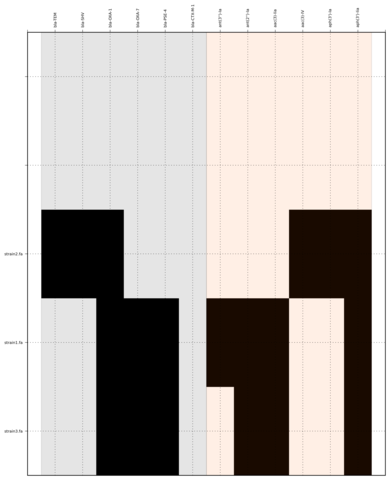
Link to full size run1.
Run 2 - Combining assembly and mapping consensus data
Command:
SeqFindr Antibiotic_markers.fa assemblies/ -m consensus/ -o run2 -l
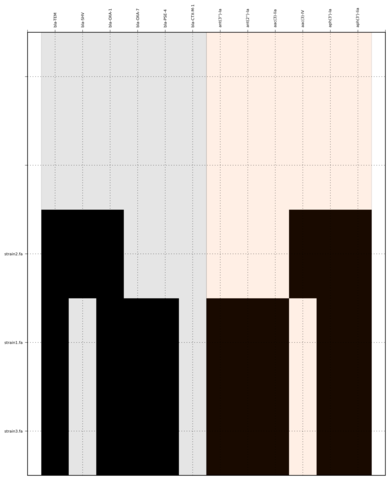
Link to full size run2.
Run 3 - Combining assembly and mapping consensus data with differentiation between hits
Command:
SeqFindr Antibiotic_markers.fa assemblies/ -m consensus/ -o run3 -l -r
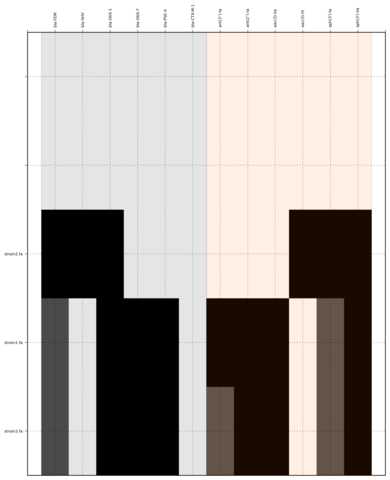
Link to full size run3.
The clustering dendrogram looks like this:
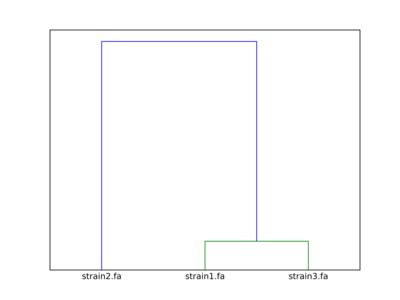
Link to full size dendrogram.
Run 4 - Combining assembly and mapping consensus data with defined ordering
Command:
SeqFindr Antibiotic_markers.fa assemblies/ -m consensus/ -o run4 -l -r --index_file dummy.order
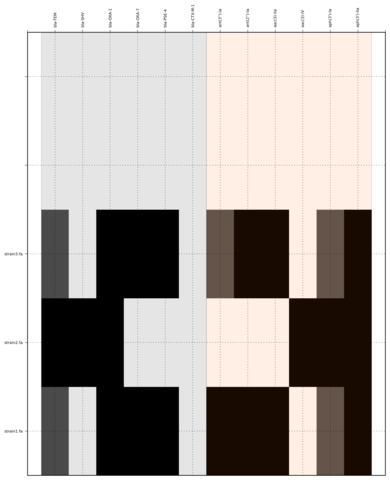
Link to full size run4.
How to generate mapping consensus data
We strongly recommend that you use mapping consensus data. It minimises the effects of missassembly and collapsed repeats.
We use Nesoni. We use the database file (in multi-fasta format) as the reference for mapping. Nesoni has no issues with multifasta files as references (BWA will treat them as separate chromosomes). The workflow is something like this:
$ nesoni make-reference myref ref-sequences.fa $ # for each strain $ # nesoni analyse-sample: mysample myref pairs: reads1.fastq reads2.fastq $ # extract the consensus.fa file
For those of you using a cluster running PBSPro see: https://github.com/mscook/SeqFindr_nesoni This is a script that generates a job array, submits and cleans up the mapping results ready for input to SeqFindr.
The output from the described workflow and SeqFindr_nesoni is a consensus.fa file which we term the mapping consensus. This file is a multi-fasta file of the consensus base calls relative to the database sequences.
- Caveats:
you will probably want to allow multi-mapping reads (giving –monogamous no –random yes to nesoni consensus) (this is default for SeqFindr_nesoni),
The (poor) alignment of reads at the start and the end of the database genes can result in N base calls. This can result in downstream false negatives.
SeqFindr now provides a solution to minimise the effects of poor mapping at the start and end of the given sequences.
The SeqFindr option is -s or –STRIP:
-s STRIP, --strip STRIP Strip the 1st and last N bases of mapping consensuses & database [default = 10]
By default this strips the 1st and last 10 bases from the mapping consensuses. We have had good results with this value. Feel free to experiment with different values (say, -s 0, -s 5, -s 10, -s 15). Please see image-compare a script we developed to compare the effects of different values of -s on the resultant figures.
SeqFindr usage options
See the help listing. You can get this yourself with:
$ SeqFindr -h
Future
Please see the TODO for future SeqFindr project directions.
Project details
Release history Release notifications | RSS feed
Download files
Download the file for your platform. If you're not sure which to choose, learn more about installing packages.
Source Distribution
Built Distribution
Hashes for SeqFindr-0.31.1-py2-none-any.whl
| Algorithm | Hash digest | |
|---|---|---|
| SHA256 | 57c2f571344f9d291c7f78ab6b7c240dfb7f343b99ecd97d725c2bf539000545 |
|
| MD5 | f22068f79c1c20cb4474c6cc0a9c6ec3 |
|
| BLAKE2b-256 | f2e823d95cc97907ff2ef0ed06d6e70a63e6614512eacace4ab949ae04c75cf8 |











